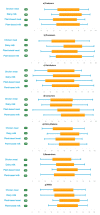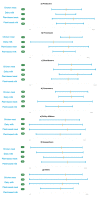Evaluating Animal-Based Foods and Plant-Based Alternatives Using Multi-Criteria and SWOT Analyses
- PMID: 33138318
- PMCID: PMC7662315
- DOI: 10.3390/ijerph17217969
Evaluating Animal-Based Foods and Plant-Based Alternatives Using Multi-Criteria and SWOT Analyses
Abstract
Global diets have transitioned in recent decades with animal and processed products increasing. Promoting a reversal in these trends towards plant-based diets could reduce the environmental impacts of food systems and reduce the prevalence of non-communicable diseases and malnutrition. In Spain, a reference point for the Mediterranean diet (predominantly plant-source based), plant-based alternatives to traditional animal-based products are receiving increased attention. However, limited focus has been given to the opinions of stakeholder groups on the potential of these novel products. We evaluate the opinions of stakeholders within the Spanish agri-food sector, using multicriteria and SWOT analyses, on traditional and novel food products. Stakeholders involved in the supply chain of food products (producers, processors, and distributors) were critical of novel plant-based foods, highlighting problems with their taste, processing technology, and high prices. These results contrast with the perspectives of policymakers, researchers, environmental NGOs, and consumers who see novel products more positively - healthier, more sustainable, and highly profitable. These results illustrate the more traditional mindset seen in Spanish production systems, contrasting with the rapidly shifting tastes and demands of consumers and the potential legislative orientation of policymakers. This study calls for improved understanding and collaboration between stakeholders to better manage complex choices that affect the future of food systems during their needed transformation.
Keywords: diet’s sustainability; high protein foods; innovation; meat; milk; perceptions; stakeholders; vegetarian substitutes.
Conflict of interest statement
The authors declare no conflict of interest.
Figures











References
-
- FAO. IFAD. UNICEF. WFP. WHO . The State of Food Security and Nutrition in the World 2020. FAO; IFAD; UNICEF; WFP; WHO; Rome, Italy: 2020. Transforming food systems for affordable healthy diets.
-
- Vermeulen S.J., Campbell B.M., Ingram J.S.I. Climate change and food systems. Annu. Rev. Environ. Resour. 2012;37:195–222. doi: 10.1146/annurev-environ-020411-130608. - DOI
-
- Aide T.M., Clark M.L., Grau H.R., López-Carr D., Levy M.A., Redo D., Bonilla-Moheno M., Riner G., Andrade-Núñez M.J., Muñiz M. Deforestation and Reforestation of Latin America and the Caribbean (2001–2010) Biotropica. 2013;45:262–271. doi: 10.1111/j.1744-7429.2012.00908.x. - DOI
Publication types
MeSH terms
LinkOut - more resources
Full Text Sources
Medical

